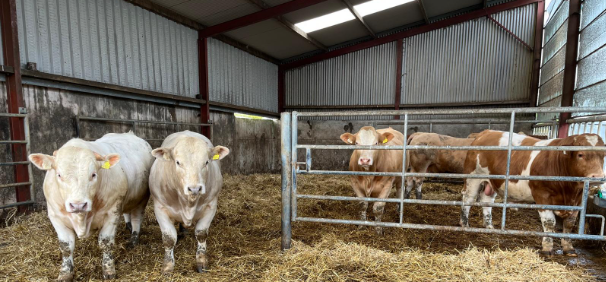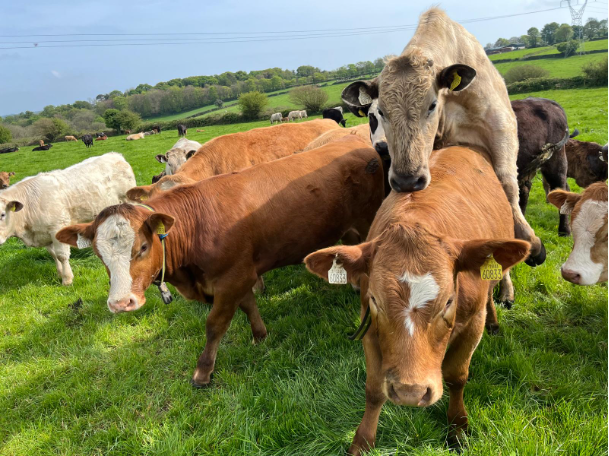15 May 2025
Bull beef and breeding with Eamon and Donnchadh McCarthy

Eamon and Donnchadh McCarthy farm in Carrigeen, Glendine, Youghal, Co. Waterford and are participants in the Teagasc Future Beef and Signpost Programmes. In this article, they share the latest happenings on their farm in terms of bull beef production, breeding and grassland management.
We run a suckler to beef enterprise, split into spring (60%) and autumn (40%) calving, consisting of 55 suckler cows. All males are finished as under 16-month bull beef, while the heifers not retained for breeding are finished at 18-20 months of age.
Bull beef
The finishing bulls are well settled on their ad-lib finishing diet. The bulls are eating approx. 12-14kg/head/day of a high energy, 13% protein coarse beef ration mixed roughly 50:50 with home-grown rolled barley. They also receive ad-lib access to silage as opposed to straw. The bulls were weighed on April 25, and the top 50% of bulls weighed 610kg liveweight and were gaining 2.42kg liveweight per day since their last weighing. The weight ranged from 533kg to 692kg.
In 2024, the bulls averaged 392kg carcass weight, graded U-3- and were finished at 15.4 months of age. The target is to achieve a carcass weight of 400kg under 16 months with this batch of bulls. The bulls are housed in straw-bedded pens, and we have found they perform better than finishing bulls on concrete slats. There are less injuries or lameness also with this system when managed correctly.
Breeding
The breeding season for the spring-calving herd commenced on May 1, allowing for calving to commence around February 10, 2026.
All maiden heifers showed heat cycles prior to breeding, and we noticed some of the heifers in heat back as early as January. We mix the maiden heifers with the spring herd for the breeding season, as we find it increases the mounting activity within the herd. Once the maiden heifers are finished breeding, they are removed to an out farm for the remainder of the grazing season until housing.

We use an automated heat detection system. The base unit for the heat detection unit is mounted in a cattle box with a solar panel attached. The unit can read as far as 500 metres to the front, 200 metres to the sides and 100 metres behind the unit.
The cows are inseminated at the optimum time of the heat cycle depending on the stage of heat. We’ve noticed that the am:pm rule in terms of breeding is in line with the automated heat detection system breeding recommendations.
Cows are separated from the herd for AI using reels, served and then returned to the field promptly. We have found that the cows get used to being drafted out for AI and generally only the animals being served are removed from the field.
The plan is to breed for approximately six weeks. We have now finished weaning the autumn herd and these cows have also been moved to the out farm, where they will remain until July, when they will be brought home for calving.
Grassland
The field earmarked for reseeding has since been burnt off with glyphosate. Initially we were going to use a direct drilling method for reseeding, but we have since decided to use two runs of a heavy disc followed by sowing with a power harrow. The field was sprayed with glyphosate approx. three weeks ago, so this should help create a good seedbed.
95% of the farm has a pH of greater than 6.2, including this field for reseeding. The recommendation would be to apply lime at reseeding to counter any acidity from the decaying sward; however, due to the fact that the field would only require a half load, the decision has been made to hold off until later in the year to apply the lime when more liming is being carried out.
The field will receive two bags per acre of 10:10:20 at sowing. We will make sure to roll the field after sowing in order to achieve good soil to seed contact and also to conserve moisture as we head into the summer. The seed mix will contain 2kg of red clover and 2kg of medium leaved white clover. The grass varieties will be selected from the Pasture Profit Index (PPI) with the aim of achieving a palatable sward which will grow well at the shoulders of the year.
The above update was first published in the Farming Examiner.
For more information on the Teagasc Signpost Programme, visit here.
Stay up to date with the latest happenings on the Future Beef Programme here.
